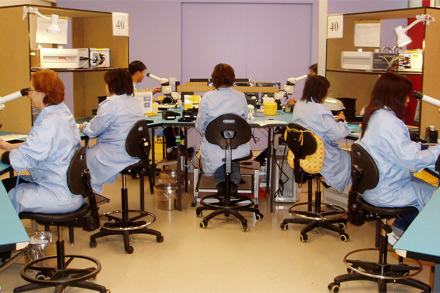 The Ask:
The Ask:
A global medical device company, a Top 100 ASX performer, launched a new product range which was well received in the market with indications of good sales potential. However, manufacturing output simply could not meet the demand and customers were becoming increasingly frustrated at not receiving their orders on time
Results and Benefits
- Output raised from 300 units per month to 4,000 (a 13-fold increase)
- 80 good units per shift produced with 7 people (a 70-fold increase in productivity)
- Quality – increased to an average 90% first pass yield
- First completed works order achieved 98% yield (company record)
- Manufacturing Cell implemented
- Manufacturing lead time reduced from over 45 days to 1 day
- 100% on time delivery
- Skills matrix developed / Team cross training for job rotation
- Avoidance of overtime and recruitment
- No increase in overheads
- Reduction in WIP
Challenges:
- The product range consisted of 2 main products which, with 4 colour variants (and 2 more to be launched), yield 20 SKUs and 120 accessories
- The output level was supposed to be 1400 units per month with aspirations to raise output levels to 3000 units per month over 6 months
- Throughput levels and yields were lower than target but were expected to rise with production experience (the actual output was 300 units per month)
- There were quality, quantity and timeliness problems with deliveries of bought-in components
- The high failure rates of incoming components and assemblies consumed valuable trained resource to rework failures and therefore, reduced capacity
- The operation was labour intensive with 30 people employed on 8hr shifts plus overtime and around 10 on afternoon shifts
- There is no automation, each piece is hand-built under microscopes
- The average lead time to produce one unit was in excess of 45 days
Implication
- Recruitment and training is long and difficult because each operator is highly skilled, therefore, the only capacity flexing is with overtime
- In order to hit output targets the company was considering recruiting and training 40-50 more employees
Objective
- To provide an end-to-end value stream map of the new product range identifying opportunities for improvement, designing how the processes should operate and implementing a manufacturing cell structure which will achieve the company’s desired output and quality targets without increasing head count, labour cost and overhead
The Approach:
Changes were implemented within the company’s framework of:
- Internal organisation structure
- Regulatory and compliance requirements
- Incoming Inspection and GMPs
- Document control and SOP processes
Toolkit
- Data collection & analysis
- Value Stream Mapping
- Design for manufacture and assembly
- FMEA
- Cell design
- Solution verification
- Implementation
- Supplier positioning
- Strategic Sourcing
- Vendor Managed Inventory
- Supplier assessment
- Batch order quantities
- Kitting
- Key Performance Indicators
- Visual Factory Management
- 5S Housekeeping
- Team Briefings
- Continuous Improvement

